While the gardens appreciate the return of our rainy season, the rains during the fall and winter months also encourage the return of a myriad of species of fungi to our woodlands.
With the rains returning early this season, we’re already finding a wide variety of fungi, large and small, dotting our slopes. As we haven’t done a Mushroom Monday post in a while, we thought we’d start the season off with the Blood-Foot Mushroom.
During a hike around the property yesterday morning I discovered a few of these small red Mycena fungi clinging to the edge of a well rotted California Bay Laurel branch. Most Mycena are quite challenging to identify, in part due to their small size, and relatively non-descript coloration.
I actually didn’t notice the Mycena at first. As is typical of this genus, the fruiting bodies of this species are easily overlooked. What I noticed initially was the large pinkish-red Russula sp. directly in front of this cluster.
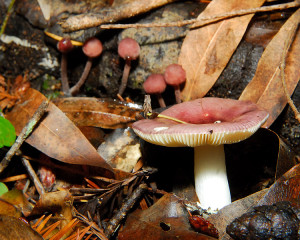
The large Russula sp. fungi in the foreground actually caught my attention, before I noticed the Mycenae behind it
Although we see various Russula sp. throughout the year, this is the first time we’ve noticed the Blood-foot Mushroom.
Mycena haematopus is a gilled species, and is common throughout both Europe, and North America.
This saprobic fungi is found on pieces of well rotted hardwood primarily during the spring and fall months, but may be found year around in mild climates.
The pileus, or cap, of Mycena haematopus averages between 1-3 cm in diameter, and is initially campanulate (bell-shaped), but becomes more convex with maturity.
These specimens are still quite young, and the caps will change in shape as they mature.
The cap is a dark brownish-red, but will become more pale pink to white in color with age, and the margin will appear more striate as the fruiting body matures. [1]
The stem, or stipe, is hollow, and a dark brownish-red, covered with irregular coarse hairs. Whitish fluffy mycelia can be found at the base of the stipe where the fungi are attached to their substrate.
A number of species of fungi may ooze a liquid, or latex, when crushed or cut, so noting such characteristics may help lead to a positive identification of some species of fungi.
Mycena haematopus is one of a few species of Mycena that is known to ‘bleed’ when the tissue is cut or damaged. Simply plucking one small fruiting body from this cluster of fungi, a purple-red juice, reminiscent of a rich Cabernet, immediately began to ooze and drip from the base of the stem.
There is a similar ‘bleeding’ species of Mycena, called Mycena sanguinolenta, but that species is typically distinguished from the Blood-Foot Mycena by M. sanguinolenta’s tendency to grow in damp soil, not on hardwood. [2]
Mycena haematopus is known to contain a number of unique chemical compounds. Four red alkaloids, haematopodin B (a pyrroloquinoline alkaloid), and mycenarubin D, E, and F have all been isolated from M. haematopus. Haematopodin B, specifically, is the primary pigment contained within the red juice of this species. [3] Pyrroloquinoline alkaloids have garnered significant research interest in recent years due to their cytotoxic and antimicrobial activities [4]. Although pyrroloquinoline alkaloids were known to occur in some marine invertebrates, before they were detected in Mycena haematopus, they were thought to be quite rare in terrestrial species.
The edibility of this species is somewhat questionable. Most Mycena reportedly have yet to have been tested for toxins. [5]
Not to mention that their small size would render this species of little to no interest to most culinarians.
Regardless, they are one of the easier, and more colorful, species of Mycena to identify. As the rainy season progresses, it will be interesting to see what other species we find here over the coming months.
—————
[1] Mycena haematopus at Mykoweb.com
[2] Mycena haematopus at MushroomExpert.com
[3] Peters S, Jaeger RJR, Spiteller P. (2008). “Red pyrroloquinoline alkaloids from the mushroom Mycena haematopus“. European Journal of Organic Chemistry 2008 (2): 319–23.
[4] Baumann C, Bröckelmann M, Fugmann B, Steffan B, Steglich W, Sheldrick WS. (1993). “Pigments of fungi. 62. Haematopodin, an unusual pyrroloquinoline derivative isolated from the fungus Mycena haematopus, Agaricales“. Angewandte Chemie—International Edition in English 32 (7): 1087–89.
[5] Volk T. (June 2002). “Mycena haematopus, the blood-foot mushroom“. Tom Volk’s Fungus of the Month. UW-Madison Department of Botany

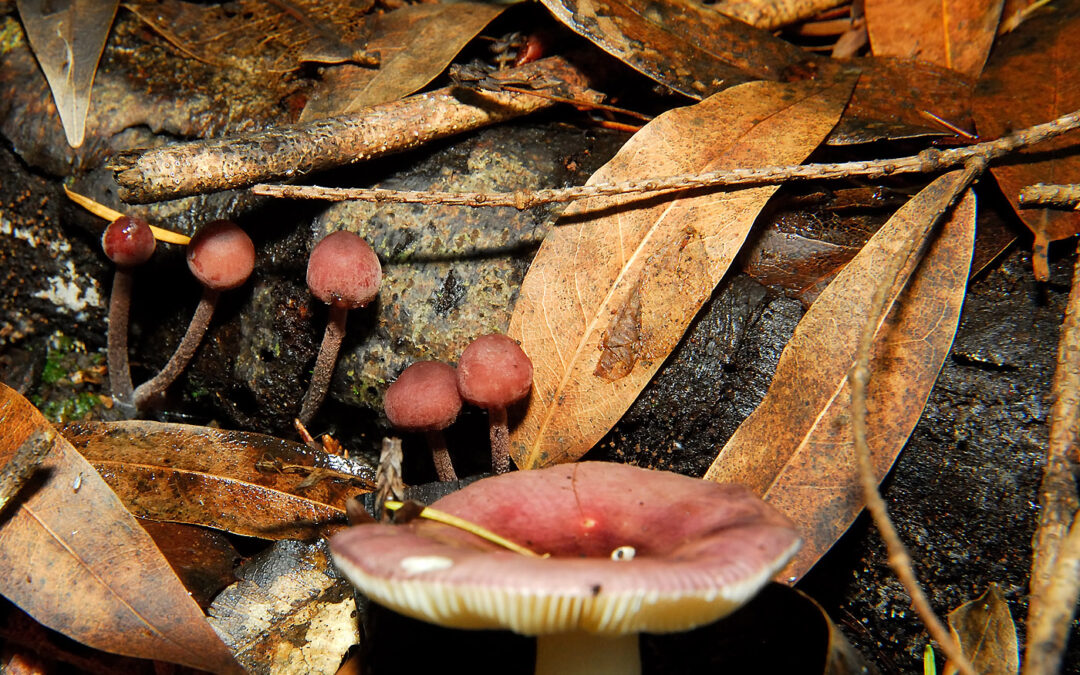


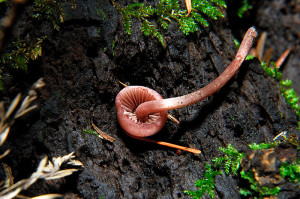
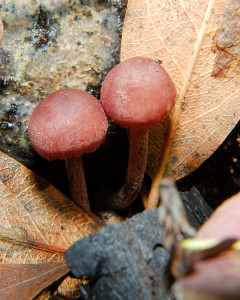
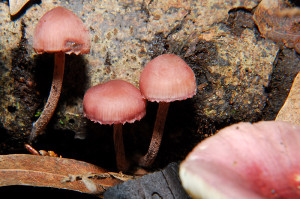
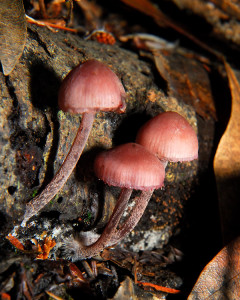
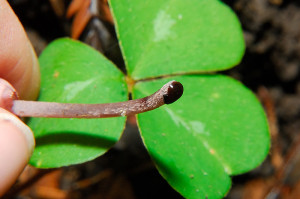
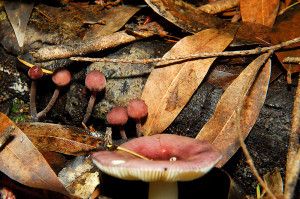
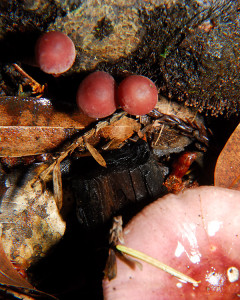
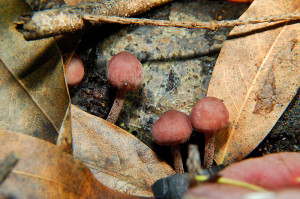







I love fungus…fascinating plants that crop up in my garden in many shapes and colors…always wanted to learn more about them…
Except technically, they’re not plants 😉 Fungi are unique enough that they reside in their own Kingdom, separate from plants. Although some do appear to be quite plant-like in their form, and they’re certainly at least as diverse!
I always love your mushroom posts because I know absolutely nothing on them. I think I can identify about two.
I don’t know too much about them either, but as I enjoy photographing them, it’s fun to get to know them a little better, and many of them I think are as beautiful as any garden plant.
Oh yah! it’s mushroom season. I guess I haven’t been getting out as much this year as I haven’t seen many mushrooms yet but I always enjoy looking at photos of them. Mushrooms make great photography subjects.
They do make great photography subjects, although lighting conditions for shooting them can be somewhat challenging. At least they don’t get up and run away while you adjust your aperture settings 😉
I know nothing about wild mushrooms, especially those who grow around us. I would never dream of eating them.
I wouldn’t dream of eating them either, but they are fun to hunt with a camera. Even though I’ve learned about some of the species growing here over the last few years, there are simply too many look-alikes to risk dining on them. It’s simply not worth it. I’ll stick to the culinary mushrooms at the Farmer’s Market for cooking with 😉
Lovely photographs of fungus. Love the blood dripping from the cut stem. Amazing stuff. Your posts are so informative.
Haha! I wish I’d found this a few weeks ago, bleeding mushrooms might have made for a good Hallowe’en post! 😉
A bleeding mushroom! You do have some interesting fungi. How did you learn so much about mushrooms? Have you taken classes, or are you a self-taught researcher? I suspect I may overlook some fascinating fungi in my own yard.
I read too much, that’s part of the problem, and there are some interesting mycology texts out there, even for the amateur like me. I haven’t taken a formal class (although I do have a background in the biological sciences). We did join the local Fungus Federation group last year though, and have attended some local fungus fairs. Those are an excellent place to learn how to better identify species of fungi that grow locally in your area. The fairs are usually held during the late winter, when the gardens are quiet anyway, and the weather is more conducive to finding them. It really helps to see examples in person, rather than just in a photograph. Our local group has some folks with handy dandy microscopes too, and they’re often willing to help ID a mystery fungus 🙂
Wow, how amazing. I suspect this mushroom might make a great dye. I’ve always been interesting in dying with mushrooms, I’ll have to remember this.
That’s a good point, I hadn’t thought of its use as a dye, but I can attest to the fact that this species will stain your fingers! 😛 The question would be, as they’re so small, how many you’d have to find to dye anything substantial.
Yes, we were on the same wavelength yesterday…glad I could participate in Mushroom Monday, even unknowingly. You have some pretty mushrooms there. Beautiful… and we joke about it, but would not eat any either… Just how did the first people to try eating these ‘shrooms manage?
I wouldn’t mind learning how to raise my own from a kit. We have the climate for that, I think. It’s nice to be able to walk around your place to find these. We do that most in the winter when the tall grasses are down. Fun!
I suspect, as with some plants, that native peoples would probably watch the wildlife as they browsed around. It’s not a guarantee that a human won’t be sickened by something another mammal can eat, but it’s not a bad start. I’ve noticed there are some species here that are more popular with the wildlife, and other species that are never touched. Of course, if they chose to eat the wrong one, it’s not like I’d know 😉 I think it would be fun to grow your own edible mushrooms though, and there are plenty of kits on the market. We certainly seem to have the right conditions!
Interesting post…makes me wish I knew a bit more about Mushrooms. I attended a Mushroom Festival in September which was great and I did learn a bit more there.
Aren’t they a fabulous learning tool? I find I learn more at a fungus fair or festival in a few hours, than I could from a book in weeks! It’s also fun to see some of the species in person that, try as I might, always seem to elude me! I will find a morel….I will find a morel…I will find a morel…well, you can’t blame me for wishful thinking anyway. 😀
VERY interesting and informative – thank you. But they make the most amazing photographic subjects, don’t they?
How fascinating Clare. I’ve never seen one of those here and I’m intrigued by the bleeding as I never knew a fungi could do that. I really do hope that you find a morel on your property soon – I’m keeping my scottish morel location a secret LOL.
Hi Clare, these are beautiful and delicate looking little mushrooms. Loved that you described the ‘bleeding’ as “reminiscent of a rich Cabernet”, clearly you are of more poetic bent than the person who gave it it’s common name 🙂
You are way, way smart! Those mushrooms look like little tootsie pops –
We have our first snow! A blanket of white which is night night for the garden